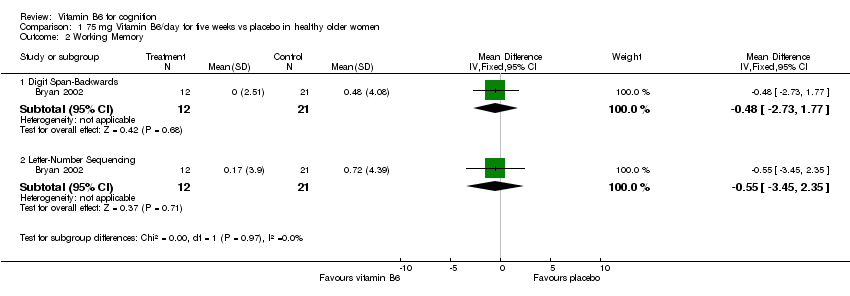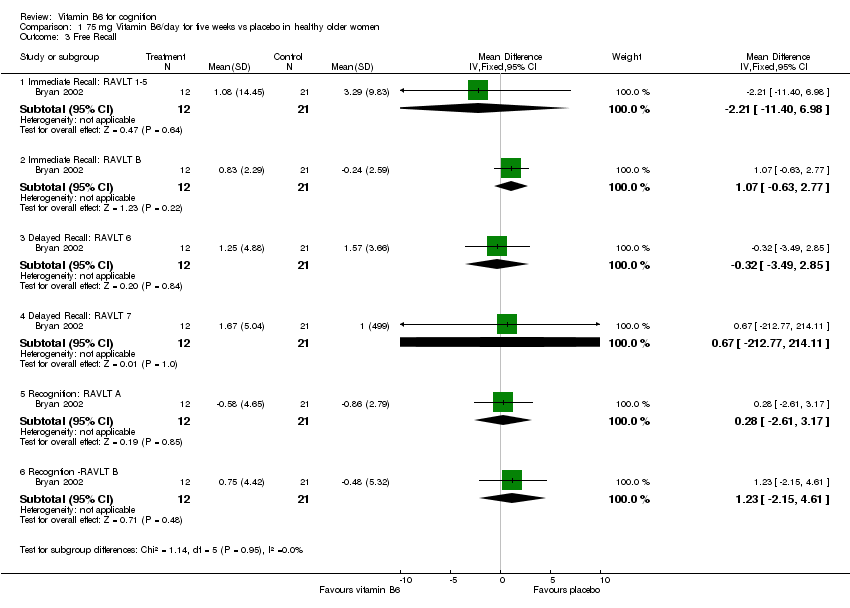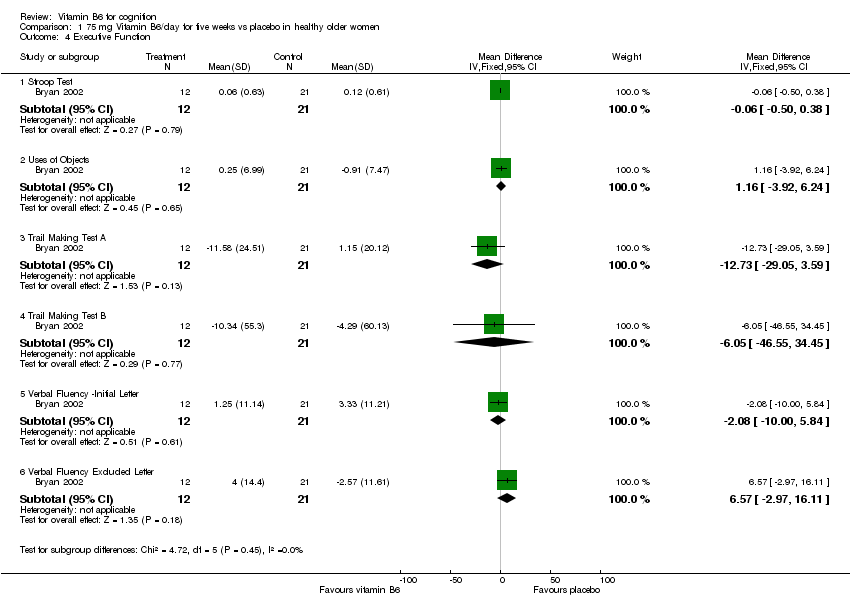El efecto de la vitamina B6 sobre la cognición
Referencias
Referencias de los estudios incluidos en esta revisión
Referencias de los estudios excluidos de esta revisión
Referencias adicionales
Referencias de otras versiones publicadas de esta revisión
Characteristics of studies
Characteristics of included studies [ordered by study ID]
Ir a:
| Methods | A 35 days randomized, double‐blind, placebo‐controlled study, a mixed factorial design was used | |
| Participants | Country: Australia *75 in older aged group (65‐92 y): Selection criteria: | |
| Interventions | 1. placebo | |
| Outcomes | A) Cognitive measures: B) Mood Measures | |
| Notes | One participant dropped out from the folic acid group | |
| Risk of bias | ||
| Bias | Authors' judgement | Support for judgement |
| Allocation concealment? | Low risk | A ‐ Adequate |
| Methods | A 12 week randomized, double‐blind, placebo‐controlled trial | |
| Participants | Country: The Netherlands Entry criteria: Exclusion criteria: | |
| Interventions | 1) Placebo | |
| Outcomes | A) Vitamin B6 status: B) Mood using the list of adjective | |
| Notes | The pairs were matching in age, vitamin B6 status and IQ | |
| Risk of bias | ||
| Bias | Authors' judgement | Support for judgement |
| Allocation concealment? | Low risk | A ‐ Adequate |
HRT: Hormone Replacement Therapy
CESD: The Center for Epidemiological Studies Depression Scale
POMS: The Profile of Mood States Questionnaire
PLP: Plasma Pyridoxal‐5'‐Phosphate
Alpha‐EAST: Erythrocyte Aspartate Aminotransferase
IQ: Intelligence Quotient
Characteristics of excluded studies [ordered by year of study]
Ir a:
| Study | Reason for exclusion |
| RCT of multi‐vitamins | |
| RCT, using folic acid plus vitamin B12, vitamin B6, vitamin B2 and placebo in patients with vascular disease. Patients with MCI and dementia were excluded | |
| Not RCT, B vitamin supplementation in Alzheimer's disease, vascular dementia, mild cognitive impairment patients | |
| Interventional study of multi‐vitamins and elements | |
| The intervention included the combination of the following vitamins: B1, B6, B12 and C | |
| RCT of micronutrient‐enriched liquid | |
| RCT, Comparing B vitamins (B6, B12, folic acid) with placebo in elderly healthy people | |
| RCT, Comparing B vitamin (B6, B12, folic acid) plus a walking programme with placebo in mild cognitive impairment patients | |
| RCT, comparing B vitamins (B6, B12, folic acid) with placebo in older men | |
| A review of the effect of B vitamins (B6, B12 , folic acid) on cognitive function | |
| RCT, comparing B vitamins (B6,B12, folic acid) to placebo | |
| RCT comparing B6, B12 and folic acid with placebo in demented persons |
MCI: Mild Cognitive Impairment
Data and analyses
| Outcome or subgroup title | No. of studies | No. of participants | Statistical method | Effect size |
| 1 Speed of processing Show forest plot | 1 | Mean Difference (IV, Fixed, 95% CI) | Subtotals only | |
| Analysis 1.1  Comparison 1 75 mg Vitamin B6/day for five weeks vs placebo in healthy older women, Outcome 1 Speed of processing. | ||||
| 1.1 Boxes Test | 1 | 33 | Mean Difference (IV, Fixed, 95% CI) | 1.57 [‐14.08, 17.22] |
| 1.2 Digit‐Symbol Coding | 1 | 33 | Mean Difference (IV, Fixed, 95% CI) | 3.89 [‐10.69, 18.47] |
| 1.3 Symbol Search | 1 | 33 | Mean Difference (IV, Fixed, 95% CI) | 0.06 [‐3.61, 3.73] |
| 2 Working Memory Show forest plot | 1 | Mean Difference (IV, Fixed, 95% CI) | Subtotals only | |
| Analysis 1.2  Comparison 1 75 mg Vitamin B6/day for five weeks vs placebo in healthy older women, Outcome 2 Working Memory. | ||||
| 2.1 Digit Span‐Backwards | 1 | 33 | Mean Difference (IV, Fixed, 95% CI) | ‐0.48 [‐2.73, 1.77] |
| 2.2 Letter‐Number Sequencing | 1 | 33 | Mean Difference (IV, Fixed, 95% CI) | ‐0.55 [‐3.45, 2.35] |
| 3 Free Recall Show forest plot | 1 | Mean Difference (IV, Fixed, 95% CI) | Subtotals only | |
| Analysis 1.3  Comparison 1 75 mg Vitamin B6/day for five weeks vs placebo in healthy older women, Outcome 3 Free Recall. | ||||
| 3.1 Immediate Recall: RAVLT 1‐5 | 1 | 33 | Mean Difference (IV, Fixed, 95% CI) | ‐2.21 [‐11.40, 6.98] |
| 3.2 Immediate Recall: RAVLT B | 1 | 33 | Mean Difference (IV, Fixed, 95% CI) | 1.07 [‐0.63, 2.77] |
| 3.3 Delayed Recall: RAVLT 6 | 1 | 33 | Mean Difference (IV, Fixed, 95% CI) | ‐0.32 [‐3.49, 2.85] |
| 3.4 Delayed Recall: RAVLT 7 | 1 | 33 | Mean Difference (IV, Fixed, 95% CI) | 0.67 [‐212.77, 214.11] |
| 3.5 Recognition: RAVLT A | 1 | 33 | Mean Difference (IV, Fixed, 95% CI) | 0.28 [‐2.61, 3.17] |
| 3.6 Recogntion ‐RAVLT B | 1 | 33 | Mean Difference (IV, Fixed, 95% CI) | 1.23 [‐2.15, 4.61] |
| 4 Executive Function Show forest plot | 1 | Mean Difference (IV, Fixed, 95% CI) | Subtotals only | |
| Analysis 1.4  Comparison 1 75 mg Vitamin B6/day for five weeks vs placebo in healthy older women, Outcome 4 Executive Function. | ||||
| 4.1 Stroop Test | 1 | 33 | Mean Difference (IV, Fixed, 95% CI) | ‐0.06 [‐0.50, 0.38] |
| 4.2 Uses of Objects | 1 | 33 | Mean Difference (IV, Fixed, 95% CI) | 1.16 [‐3.92, 6.24] |
| 4.3 Trail Making Test A | 1 | 33 | Mean Difference (IV, Fixed, 95% CI) | ‐12.73 [‐29.05, 3.59] |
| 4.4 Trail Making Test B | 1 | 33 | Mean Difference (IV, Fixed, 95% CI) | ‐6.05 [‐46.55, 34.45] |
| 4.5 Verbal Fluency ‐Initial Letter | 1 | 33 | Mean Difference (IV, Fixed, 95% CI) | ‐2.08 [‐8.00, 5.84] |
| 4.6 Verbal Fluency Excluded Letter | 1 | 33 | Mean Difference (IV, Fixed, 95% CI) | 6.57 [‐2.97, 16.11] |
| 5 Verbal Ability Show forest plot | 1 | Mean Difference (IV, Fixed, 95% CI) | Subtotals only | |
| Analysis 1.5  Comparison 1 75 mg Vitamin B6/day for five weeks vs placebo in healthy older women, Outcome 5 Verbal Ability. | ||||
| 5.1 Vocabulary | 1 | 33 | Mean Difference (IV, Fixed, 95% CI) | 0.74 [‐6.02, 7.50] |
| 5.2 Spot the Word | 1 | 33 | Mean Difference (IV, Fixed, 95% CI) | ‐1.65 [‐14.14, 10.84] |
| 6 Mood Measures Show forest plot | 1 | Mean Difference (IV, Fixed, 95% CI) | Subtotals only | |
| Analysis 1.6  Comparison 1 75 mg Vitamin B6/day for five weeks vs placebo in healthy older women, Outcome 6 Mood Measures. | ||||
| 6.1 CESD | 1 | 33 | Mean Difference (IV, Fixed, 95% CI) | 0.61 [‐4.78, 6.00] |
| 6.2 POMS total | 1 | 33 | Mean Difference (IV, Fixed, 95% CI) | 2.77 [‐12.28, 17.82] |
| 6.3 Tension/Anxiety | 1 | 33 | Mean Difference (IV, Fixed, 95% CI) | 0.20 [‐4.27, 4.67] |
| 6.4 Depression/dejection | 1 | 33 | Mean Difference (IV, Fixed, 95% CI) | ‐0.64 [‐4.78, 3.50] |
| 6.5 Anger/hostility | 1 | 33 | Mean Difference (IV, Fixed, 95% CI) | ‐1.28 [‐5.22, 2.66] |
| 6.6 Vigour/Activity | 1 | 33 | Mean Difference (IV, Fixed, 95% CI) | ‐2.35 [‐8.42, 3.72] |
| 6.7 Fatigue/inertia | 1 | 33 | Mean Difference (IV, Fixed, 95% CI) | 1.38 [‐2.16, 4.92] |
| 6.8 Confusion/bewilderment | 1 | 33 | Mean Difference (IV, Fixed, 95% CI) | 0.4 [‐1.90, 2.70] |
| Outcome or subgroup title | No. of studies | No. of participants | Statistical method | Effect size |
| 1 PLP Show forest plot | 1 | 76 | Mean Difference (IV, Fixed, 95% CI) | 238.00 [211.58, 264.42] |
| Analysis 2.1  Comparison 2 20 mg vitamin B6/day for 12 weeks vs placebo in healthy older men, Outcome 1 PLP. | ||||
| 2 Alpha‐EAST Show forest plot | 1 | 76 | Mean Difference (IV, Fixed, 95% CI) | 0.43 [0.30, 0.56] |
| Analysis 2.2  Comparison 2 20 mg vitamin B6/day for 12 weeks vs placebo in healthy older men, Outcome 2 Alpha‐EAST. | ||||
| 3 Associated Recognition Task Show forest plot | 1 | 76 | Mean Difference (IV, Fixed, 95% CI) | ‐1.02 [‐2.40, 0.36] |
| Analysis 2.3  Comparison 2 20 mg vitamin B6/day for 12 weeks vs placebo in healthy older men, Outcome 3 Associated Recognition Task. | ||||
| 4 Forget Scores Show forest plot | 1 | 76 | Mean Difference (IV, Fixed, 95% CI) | 0.79 [‐0.34, 1.92] |
| Analysis 2.4  Comparison 2 20 mg vitamin B6/day for 12 weeks vs placebo in healthy older men, Outcome 4 Forget Scores. | ||||

Comparison 1 75 mg Vitamin B6/day for five weeks vs placebo in healthy older women, Outcome 1 Speed of processing.

Comparison 1 75 mg Vitamin B6/day for five weeks vs placebo in healthy older women, Outcome 2 Working Memory.

Comparison 1 75 mg Vitamin B6/day for five weeks vs placebo in healthy older women, Outcome 3 Free Recall.

Comparison 1 75 mg Vitamin B6/day for five weeks vs placebo in healthy older women, Outcome 4 Executive Function.

Comparison 1 75 mg Vitamin B6/day for five weeks vs placebo in healthy older women, Outcome 5 Verbal Ability.

Comparison 1 75 mg Vitamin B6/day for five weeks vs placebo in healthy older women, Outcome 6 Mood Measures.

Comparison 2 20 mg vitamin B6/day for 12 weeks vs placebo in healthy older men, Outcome 1 PLP.

Comparison 2 20 mg vitamin B6/day for 12 weeks vs placebo in healthy older men, Outcome 2 Alpha‐EAST.

Comparison 2 20 mg vitamin B6/day for 12 weeks vs placebo in healthy older men, Outcome 3 Associated Recognition Task.

Comparison 2 20 mg vitamin B6/day for 12 weeks vs placebo in healthy older men, Outcome 4 Forget Scores.
| Outcome or subgroup title | No. of studies | No. of participants | Statistical method | Effect size |
| 1 Speed of processing Show forest plot | 1 | Mean Difference (IV, Fixed, 95% CI) | Subtotals only | |
| 1.1 Boxes Test | 1 | 33 | Mean Difference (IV, Fixed, 95% CI) | 1.57 [‐14.08, 17.22] |
| 1.2 Digit‐Symbol Coding | 1 | 33 | Mean Difference (IV, Fixed, 95% CI) | 3.89 [‐10.69, 18.47] |
| 1.3 Symbol Search | 1 | 33 | Mean Difference (IV, Fixed, 95% CI) | 0.06 [‐3.61, 3.73] |
| 2 Working Memory Show forest plot | 1 | Mean Difference (IV, Fixed, 95% CI) | Subtotals only | |
| 2.1 Digit Span‐Backwards | 1 | 33 | Mean Difference (IV, Fixed, 95% CI) | ‐0.48 [‐2.73, 1.77] |
| 2.2 Letter‐Number Sequencing | 1 | 33 | Mean Difference (IV, Fixed, 95% CI) | ‐0.55 [‐3.45, 2.35] |
| 3 Free Recall Show forest plot | 1 | Mean Difference (IV, Fixed, 95% CI) | Subtotals only | |
| 3.1 Immediate Recall: RAVLT 1‐5 | 1 | 33 | Mean Difference (IV, Fixed, 95% CI) | ‐2.21 [‐11.40, 6.98] |
| 3.2 Immediate Recall: RAVLT B | 1 | 33 | Mean Difference (IV, Fixed, 95% CI) | 1.07 [‐0.63, 2.77] |
| 3.3 Delayed Recall: RAVLT 6 | 1 | 33 | Mean Difference (IV, Fixed, 95% CI) | ‐0.32 [‐3.49, 2.85] |
| 3.4 Delayed Recall: RAVLT 7 | 1 | 33 | Mean Difference (IV, Fixed, 95% CI) | 0.67 [‐212.77, 214.11] |
| 3.5 Recognition: RAVLT A | 1 | 33 | Mean Difference (IV, Fixed, 95% CI) | 0.28 [‐2.61, 3.17] |
| 3.6 Recogntion ‐RAVLT B | 1 | 33 | Mean Difference (IV, Fixed, 95% CI) | 1.23 [‐2.15, 4.61] |
| 4 Executive Function Show forest plot | 1 | Mean Difference (IV, Fixed, 95% CI) | Subtotals only | |
| 4.1 Stroop Test | 1 | 33 | Mean Difference (IV, Fixed, 95% CI) | ‐0.06 [‐0.50, 0.38] |
| 4.2 Uses of Objects | 1 | 33 | Mean Difference (IV, Fixed, 95% CI) | 1.16 [‐3.92, 6.24] |
| 4.3 Trail Making Test A | 1 | 33 | Mean Difference (IV, Fixed, 95% CI) | ‐12.73 [‐29.05, 3.59] |
| 4.4 Trail Making Test B | 1 | 33 | Mean Difference (IV, Fixed, 95% CI) | ‐6.05 [‐46.55, 34.45] |
| 4.5 Verbal Fluency ‐Initial Letter | 1 | 33 | Mean Difference (IV, Fixed, 95% CI) | ‐2.08 [‐8.00, 5.84] |
| 4.6 Verbal Fluency Excluded Letter | 1 | 33 | Mean Difference (IV, Fixed, 95% CI) | 6.57 [‐2.97, 16.11] |
| 5 Verbal Ability Show forest plot | 1 | Mean Difference (IV, Fixed, 95% CI) | Subtotals only | |
| 5.1 Vocabulary | 1 | 33 | Mean Difference (IV, Fixed, 95% CI) | 0.74 [‐6.02, 7.50] |
| 5.2 Spot the Word | 1 | 33 | Mean Difference (IV, Fixed, 95% CI) | ‐1.65 [‐14.14, 10.84] |
| 6 Mood Measures Show forest plot | 1 | Mean Difference (IV, Fixed, 95% CI) | Subtotals only | |
| 6.1 CESD | 1 | 33 | Mean Difference (IV, Fixed, 95% CI) | 0.61 [‐4.78, 6.00] |
| 6.2 POMS total | 1 | 33 | Mean Difference (IV, Fixed, 95% CI) | 2.77 [‐12.28, 17.82] |
| 6.3 Tension/Anxiety | 1 | 33 | Mean Difference (IV, Fixed, 95% CI) | 0.20 [‐4.27, 4.67] |
| 6.4 Depression/dejection | 1 | 33 | Mean Difference (IV, Fixed, 95% CI) | ‐0.64 [‐4.78, 3.50] |
| 6.5 Anger/hostility | 1 | 33 | Mean Difference (IV, Fixed, 95% CI) | ‐1.28 [‐5.22, 2.66] |
| 6.6 Vigour/Activity | 1 | 33 | Mean Difference (IV, Fixed, 95% CI) | ‐2.35 [‐8.42, 3.72] |
| 6.7 Fatigue/inertia | 1 | 33 | Mean Difference (IV, Fixed, 95% CI) | 1.38 [‐2.16, 4.92] |
| 6.8 Confusion/bewilderment | 1 | 33 | Mean Difference (IV, Fixed, 95% CI) | 0.4 [‐1.90, 2.70] |
| Outcome or subgroup title | No. of studies | No. of participants | Statistical method | Effect size |
| 1 PLP Show forest plot | 1 | 76 | Mean Difference (IV, Fixed, 95% CI) | 238.00 [211.58, 264.42] |
| 2 Alpha‐EAST Show forest plot | 1 | 76 | Mean Difference (IV, Fixed, 95% CI) | 0.43 [0.30, 0.56] |
| 3 Associated Recognition Task Show forest plot | 1 | 76 | Mean Difference (IV, Fixed, 95% CI) | ‐1.02 [‐2.40, 0.36] |
| 4 Forget Scores Show forest plot | 1 | 76 | Mean Difference (IV, Fixed, 95% CI) | 0.79 [‐0.34, 1.92] |

